Learn about the benefits of constructing a multi-year internship from a MLIS student's perspective.

Supporting communities through successful engagement
By Brandi Gillett and Julia Campbell
The pandemic has challenged the way libraries connect and engage with their local communities. The OPLA Community-Led Think Tank recently hosted a Community Conversation on April 14 that highlighted real examples of how public libraries are finding different ways to build community relationships. Here, we share some of the exciting findings shared by each of the presenters and what they might mean for the future of community librarianship.
Presenters:
Myke Atkinson, Service Design Lead, Calgary Public Library
Matthew Wagner, Senior Client Experience Associate, Pickering Public Library
Brady Williamson, Senior Client Experience Associate, Pickering Public Library
Sylvia Mueller, Information Barrie Coordinator, Barrie Public Library
Creating engaging Family Storytime & Baby Rhyme Time online programs
Calgary Public Library (CPL) launched online programs in July 2020, including a 30-minute Family Storytime and a 45-minute Baby Storytime. Myke Atkinson listed a set of best practices derived from CPL’s experience and emphasized the importance of active participation in programs: “Active participation is especially important for children’s programs, where the kids may have limited attention spans and parents may be concerned about the amount of screen time their children are getting. By incorporating techniques that get the children to become active participants in the program, we can break the spell of the screen and provide children with many of the social and connective benefits that have been impacted by the pandemic.”
Platform tools
CPL uses Zoom and Microsoft Teams as platforms for their programs. The library has tried to make the most of their features, purchasing additional tools to further platform utility. For example, a document camera more effectively shows turning pages for story times. Ring lights and headsets are cheap ways to increase visual and audio quality. While every new platform or tool requires staff training and having two staff members for each program makes it hard to grow their numbers, CPL has strong customer engagement.
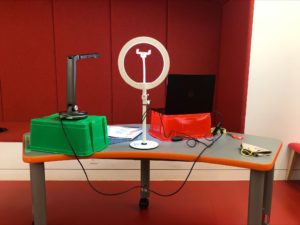
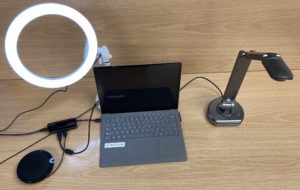
Customer engagement in Baby Rhyme Time
CPL encourages parents to use their baby’s name in Zoom name displays, letting staff continue the in-person programming tradition of using names in songs and rhymes. CPL includes a 5–7 minute break in the middle of these programs to let parents have non-moderated conversations.
Best practices
- Focus on creating connections between patrons, such as peer-to-peer learning and building community connections, which benefits community mental health.
- Customers are encouraged to keep their video on so everyone can see each other.
- View all participants to forge a sense of connection and pick up on visual cues.
- Open channels for non-verbal communication, including chat and reaction features.
- Limit recording of programs. If a program can be recorded and put on YouTube and the value is the same as attending live, the program was not designed properly.
- If possible, have two staff members attend programs where one oversees technology and one is the host and engages with customers.
- One of their goals is to capture better statistics, such as the number of screens attending, as well as the number of people behind each screen.
By following these practices, CPL’s Baby Rhyme Time’s average rating increased from 7.9 to 9/10, according to participant surveys.
Teen Discord servers in library programming
Brady Williamson and Matthew Wagner from Pickering Public Library (PPL) shared their experience with using Discord for teens. Discord is a tool for creating online communities, like a chat room or forum, using text, video, and voice chat.
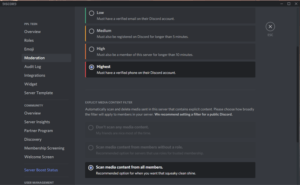
Transitioning to Discord
The Teen Advisory Group (TAG) at PPL tested out Discord and found it easy to use. PPL decided to start using it for smaller programs, such as Dungeons and Dragons with a maximum of 6 participants, and then expanded it to higher-attendance programs. Staff created and posted a set of instructions for using Discord to the PPL website.
Advantages of using Discord
Discord has facilitated TAG group project work, easily allowing members to share files, ideas, schedules and to conduct their own meetings. PPL found some of its technical features useful too, giving staff power to turn down participants’ microphones and share programming calendars.
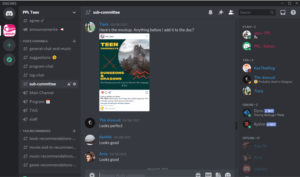
Challenges to overcome
Using Discord for some programs but not others was confusing to customers. And, as with any online community, there is the potential for abuse and inappropriate behavior, so staff monitoring is necessary. Discord’s programming allowed PPL to create a bot to help with monitoring.
Summary of experience
Overall, teens have loved Discord and PPL has received great feedback from teens and parents. It has been easy to use for both staff and clients and has given the teens a virtual community space where they can hang out during the pandemic.
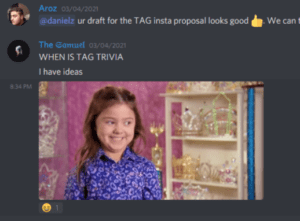
Creating a Community Hub
Sylvia Mueller from Barrie Public Library (BPL) spoke about creating a Community Hub to connect local businesses with social agencies. For example, many restaurants had perishable food leftover due to the lockdown that they could donate to community members.
Using the Better Impact database system, businesses post what they have available and social agencies go “shopping” for needed items. BPL gave each participating business and agency their own log-in credentials to create a sense of ownership and empowerment.
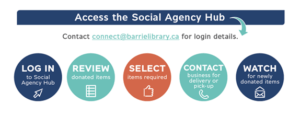
Value of the Community Hub project
Because of this project, businesses and social agencies formed lasting relationships and were able to provide the community with items of need. The project has raised the question of “how can the library help with this?” more often and positioned BPL as an adaptive and valuable community player.
How libraries are successfully engaging with their communities
Following the formal presentations, attendees had an opportunity to connect in smaller groups to discuss how libraries have continued to develop relationships. These discussions highlighted a wide range of services and creative programs:
- Storywalks and scavenger hunts
- Interactive Family Programming
- Multi-platform Teen Programming
- Take and Make programming Kits connected to virtual programs
- Virtual Storytime
- Contactless Curbside Pickup
- Expanding access to online databases and e-resources
- Friendly Calls and care calls for seniors
Challenges to staying connected
Libraries across the province have pivoted services and developed innovative ways to engage library users, but staying connected has not been simple. Some of the challenges Libraries have faced:
- Community agencies do not have the tools or technology to do virtual programming.
- Learning new technology, platforms, and software to deliver programs.
- Internet connectivity challenges in rural areas.
- Staff resources and burnout.
- Zoom fatigue.
- Engaging an older demographic who are not as engaged online.
- Understanding digital permissions, licenses, agreements and adapting privacy policies.
- Changing public health guidelines and regulations.
Lessons and strategies on engagement
Some broad lessons and strategies learned this year include:
- Think differently about how we can connect with our community.
- Have a robust and easily navigable web presence.
- Use a combination of new and old technologies to engage users.
- Record content so users can access programs on their own time.
- Stay ‘open’ and accessible through curbside and home library services, service partners and community organizations have connected with the library to deliver resources.
The future of community librarianship
It is obvious that libraries have learned from the experiences of this past year. Despite the challenges that may lie ahead, the future of community-led librarianship is bright with a focus on:
- Hybrid virtual and in-person programs
- Active online virtual programs (rather than passive)
- Curbside service and alternative forms of service delivery
- Increased collaboration across library systems
- More partnerships and programs with service providers.
It has been a year of learning. Libraries pivoted quickly to new ways of offering services to the public—the core of our mission. When Library doors were abruptly closed, we immediately opened our digital communications, collaborations and creative activities to reach the public in ways as novel as the virus that forced the closures.
For more information:
- A recording can be found here: https://youtu.be/fDiEeXI7VPs
- Slides and handouts from the speakers are posted to the event page: https://accessola.com/community-led-think-tank/
Julia Campbell is the Adult Services Librarian at the Ajax Public Library. In this role, she plans and implements programs for adults and connects with community organizations to build partnerships that will benefit the Ajax community.
Brandi is the Community Librarian at Halton Hills Public Library. As a Community Librarian, she is responsible for building and growing partnerships with local organizations to engage and connect library users and non-library users to the information, services and resources they require.


